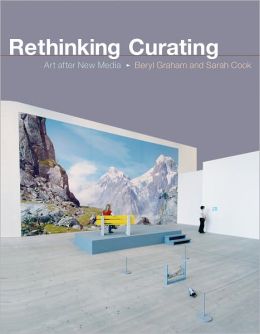Hegel noted in his Ästhetik that “art had worked itself out” and was being displaced by rational inquiry, a continent drift from sense to sensibility that began during his time and has accelerated in ours. Soon after Hegel’s thought photography rapidly developed, followed by the first illusion of motion, the 1834 Zoetrope, followed by the first movie player Eadweard Muybridge’s Zoopraxiscope in 1879.
Other variance of the fine arts, outside of film, were incremental until the 1960’s when what we would now recognize as New Media began appearing with a vengeance as artists reached beyond painting and sculpture with the video pioneering of Nam June Paik and Wolf Vostell and the multiple-media performances by the Fluxus group.
 Today the types of New Media already on the ever-expanding list are so numerous as to make one dizzy: Motion Graphics, Bio-art, Information Art, Net Art, Systems Art, Glitch Art, Hacktivism, Robotic Art, GPS Tracking, and others. Now, how does one gather it?
Today the types of New Media already on the ever-expanding list are so numerous as to make one dizzy: Motion Graphics, Bio-art, Information Art, Net Art, Systems Art, Glitch Art, Hacktivism, Robotic Art, GPS Tracking, and others. Now, how does one gather it?
In Rethinking Curating, the learned authors, Beryl Graham and Sarah Cook, both from the University of Sunderland, rankle at the term New Media which is generally in currency but will not offer a substitute, instead they encourage us to “use verbs of behavior rather than nouns of medium.”
This verb-not-noun notion appeared in Buckminster Fuller’s poem “God is a Verb” published by the Whole Earth Catalog in 1968 and indeed the authors continue Fuller’s notions of interactivity and dynamic systems, producing their own “Whole Earth Catalog” for curators with an exhausting compilation of everything from Rafael Lozano-Hemmer’s telematic 2001 Body Moves, where a computer responds to body movement of the audience to Andreja Kuluncic 2001 Distributive Justice (with multiple co-authors) a web based voting system.
Also included are many historical works, the chapter “Time” features a 1968 chess match between Marcel Duchamp and John Cage wherein the chessboard is wired to generate a musical composition based upon their chess moves, the sound of strategy.
One wonders what role the curator would have during these interactive programs and the authors offer, “act as the gracious host between the artwork and the audience—provide a platform.” This strikes me as a little thin, with all the great fun going on being relegated to a Tupper Ware host will probably not result in many curtsies.
But in the chapter “Other Modes of Curating” problems are noted in festivals where there is “a tendency to treat media artists as if they were immaterial themselves” resulting in “financial volunteerism,” expecting the artist to pony up for the project themselves. Here one remedy is to mix venues, and other nuts and bolts advice is given in chapters such as “The Embedded Curator,” “The Adjunct Curator” and “The Independent Curator.” Additionally the authors further this “behaviors” curating craft with their web site CRUMB, a giddy acronym for Curating Resource for Upstart Media Bliss, airing these issues as they develop.
They take issue with Steven Dietz’ decade old comment that “There is no great net art” (Mr. Dietz wrote the forward for this volume) explaining that the standards of quality in painting and sculpture simply don’t apply, its not what it looks like, it is what it does.
This has been the stock problem with the gate- keepers of the museums that might exhibit this work, that it is unsightly; Graham and Cook chalk this up to poor education in art technology, especially the history of the same, resulting in a patchwork esthetic interpretation. Hence much of this book addresses the history of new media providing a critical framework for judging, giving this book a unique role.
Rethinking Curating is an issue of MIT Press’ Leonardo series, a think tank for areas of knowledge that are under rapid fire development especially those showing a convergence of disciplines as do new media art, or behaviors or whatever you may call it. One name the book uses a few times is “Turing-land” as opposed to “Duchamp-land”, Alan Turing having pioneered computer code in the 1930’s, also they fancy “post-media”. I’ll stick with Turingland as “post” anything communicates unformed and reactionary, whereas Turingland has unique roots and is blossoming everywhere.
The book is prepared for teaching but doubles as a scholarly document, the bibliography alone runs to an impressive 35 pages.
Major issues are presented here in an organized way not often found in art world literature, for instance “Why Would a New Media Artist Want to Exhibit in an Art Museum,” (answered well, actually) or “Dematerialized or Just Distributed,” (still up in the air). Admittedly, my previous interest in new media has been only casual but I found this book opened my eyes to the vastness of behaviors in Turingland and I can see this book becoming part of a standard syllabus for museum studies everywhere.
BASIC FACTS: Rethinking Curating Art After the New Media by Beryl Graham and Sarah Cook. London: The MIT Press. 354 pages.
__________________________________
Copyright 2014 Hamptons Art Hub LLC. All rights reserved.

a superb use of the hegel at the top and a solid essay-review
bravo
c riley